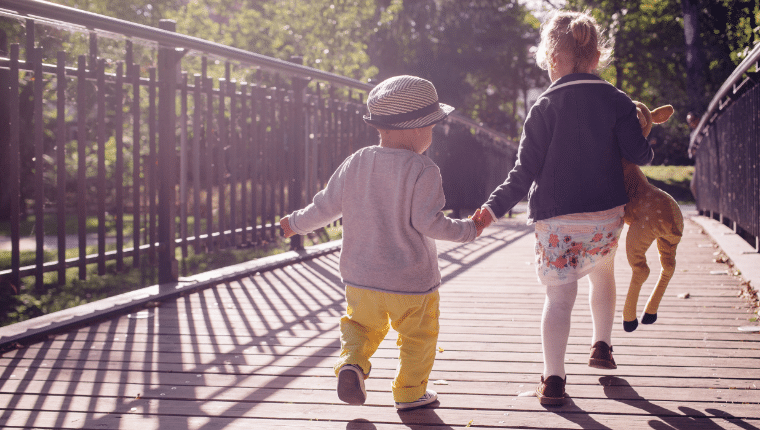Relationships are at the very heart of early learning and development. Through their early interactions babies learn to feel secure, to communicate, and to enjoy being with people. As they grow and develop, toddlers and young children love to…
Children build relationships, communicate, express love and affection, play together, learn, and have their needs met through contact with others. Have you ever asked yourself “How do I interact with the children I work with” and reflected on how this affects them and could possibly be improved or changed? Probably much more frequently than you have asked yourself “How do I interact with members of my team, outside agencies, and other professionals?” As a way of modelling to children positive interactions. This too, is an important question to reflect upon regularly.
Many interactions just happen while others come about through careful planning and decision-making. A number of factors influence the adult’s decisions about when and how to interact with children, such as, their expertise, experience and view of their role in fostering children’s learning and development as well as any particular situation they find themselves in. In addition, some children require significant support for extended periods of time, while others require less and over shorter timeframes.
Children’s learning and development are also shaped by relationships with the important people in their lives. Positive and respectful interactions between all the adults in their lives influence how children interact with others. So how can you have positive interactions with children? Good adult/child interactions are respectful, playful, enjoyable, enabling, and rewarding. Through these the adult respects all children as individuals with rights, builds on children’s abilities, interests, experiences, cultures, and backgrounds, provides for their needs and facilitates them to initiate activities, to make choices, and to become increasingly independent and responsible. They also consider additional needs or supports children may require in order to participate as fully as possible, give children feedback on what they are doing, names and affirms their efforts, celebrates their progress and achievements, and helps them to learn from mistakes, setbacks and challenges.
Of course, we cannot forget the child’s family and it is vital that you establish and maintain good relationships with children’s families, where you ensure they are welcomed, collaborated with and shown that you really their input in their child’s education.
There are a number of strategies you can use when looking at teacher (adult)/child interactions. Briefly, they are:
Building relationships:
- Children learn by being with others
- This strategy includes methods which the adult uses to build relationships and to create an environment in which children feel secure and confident enough to take risks, to explore, to take part in challenging experiences, and to direct and co-direct their own learning
Facilitating:
- Children learn by being involved in making choices and decisions, and by feeling in control
- Learning is enjoyable and rewarding for them when they challenge themselves and when they can use and build on their existing knowledge, understanding and skills
- They enjoy learning through child initiated activities
- This strategy includes methods which the adult uses to encourage children to take the lead or to share the lead with adults
Organising:
- Children learn in a well-planned and well-resourced environment
- The environment represents all children in the setting and makes learning challenging and fun
- This strategy includes methods which the adult uses to create and maintain such as an environment, including reflecting on the learning that is occurring in the environment and planning ways to enhance it
Directing:
- Children learn through planned and guided activities which build on their interests and experiences
- This strategy includes methods which the adult uses to focus on children’s learning and to develop particular dispositions, values and attitudes, skills, knowledge, and understanding
To get a better picture of the importance of interactions in the learning and development of children, we must also look at child/child or peer interactions. Throughout a typical preschool day, there are countless opportunities for children to interact and play with one another. Peer interactions serve a variety of important roles for pre-schoolers throughout the day, as they watch, imitate, model, and interact with each other, young children learn to share, take turns, solve problems, and collaborate.
They also build relationships and friendships that promote positive social and emotional development, relationships with peers provide children with emotional support, the opportunity to play with a friend, and experiences in leading, following, negotiating, conflict resolution, making mistakes, and taking risks. They also learn skills and develop knowledge and values through interactions with peers and mixed-age groups of children. The nature of children’s interactions with other children depends on their social skills as they learn to understand and to balance their own ‘wants’ with those of others.
Child-child interactions thrive in settings where children have time each day to play, work, interact, and communicate with the same group of children, and where they are encouraged and supported to seek help from and offer help to each other. These skills don’t all come naturally, however, and some children have difficulty interacting with their peers and building friendships. Positive social interactions are interactions that take place between peers that are positive in nature and successful for both children involved. These peer interactions are important because they lead to positive social and emotional development in children.
Research has shown that children who can interact successfully with their peers, even during preschool, are more popular, have stronger friendships, and are included more often in activities than children who lack these skills. Children have many strategies that they use to interact with one another; some of these strategies are appropriate and some are not.
It is important to teach children positive skills that they can use to successfully interact with their peers. Adults play a key role in supporting interactions between children.
Interested in learning more about this topic? Check out our course – Learning & Developing Through Interaction – via the Online Learning Hub.


